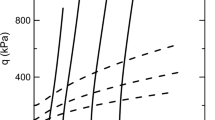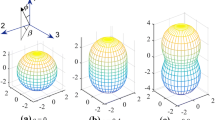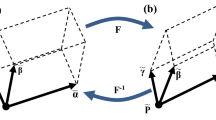Abstract
A rational study has been made to describe the behavior of anisotropic granular materials by a hypoplastic constitutive equation. The concept of the microstructure tensor in describing the anisotropy has been implemented to develop a general form of a hypoplastic constitutive equation for anisotropic materials. Attempt was made to present all formulations in a rational way with no additional assumption. Both inherent and induced anisotropy have been studied and the evolution of the material internal structure has been rationally defined through an evolutionary function. Since all developments are primarily mathematical, no particular form of a constitutive equation has been assumed. Verifications by some available experimental data reveal the success of the proposed developments outlined in this study.















Similar content being viewed by others
Notes
Private communication with Prof. Mojtaba Mahzoon, Professor in Applied Mechanics and Mathematics, School of Mechanical Engineering, Shiraz University, Shiraz, Iran (Winter, 2021), with reference to non-standard analysis invented by Abraham Robinson (1960s). Robinson and his coworkers proved that every polynomially compact linear operator on a Hilbert space has an invariant subspace (Bernstein and Robinson, 1966).
References
Arthur JRF, Menzies BK (1972) Inherent anisotropy in a sand. Géotechnique 22(1):115–129. https://doi.org/10.1680/geot.1972.22.1.115
Atkinson JH, Bransby PL (1978) The mechanics of soils: an introduction to critical state soil mechanics. McGraw-Hill, London
Azami A, Pietruszczak S, Guo P (2010) Bearing capacity of shallow foundations in transversely isotropic granular media. Int J Numer Anal Meth Geomech 34(8):771–793. https://doi.org/10.1002/nag.827
Bauer E (1996) Calibration of a comprehensive hypoplastic model for granular materials. Soils Found 36(1):13–26. https://doi.org/10.3208/sandf.36.13
Bauer E, Huang W, Wu W (2004) Investigations of shear banding in an anisotropic hypoplastic material. Int J Solids Struct 41(21):5903–5919. https://doi.org/10.1016/j.ijsolstr.2004.05.052
Bauer E, Wu W, Huang W (2003) Modeling inherent and induced anisotropy in hypoplasticity. In: Bagi K (eds) Proceedings of the international workshop on quasi-static deformations of particulate materials (QuaDPM17). Budapest, Hungary, pp 43–49
Beghini A, Bažant ZP, Chambon R, Niemunis A, Kolymbas D, Herle I (2004) Shear and objective stress rates in hypoplasticity by D. Kolymbas and I. Herle. author’s reply to discussion by A. Beghini and Z. P. Bazant, R. Chambon and A. Niemunis of ‘shear and objective stress rates in hypoplasticity’. Int J Numer Anal Methods Geomech 28(4):365–372. https://doi.org/10.1002/nag.337
Casagrande A, Carillo N (1944) Shear failure of anisotropic materials. Soil Mech Found Eng 53(6):47–58
Dafalias YF, Papadimitriou AG, Li XS (2004) Sand plasticity model accounting for inherent fabric anisotropy. J Eng Mech 130(11):1319–1333. https://doi.org/10.1061/(ASCE)0733-9399(2004)130:11(1319)
Drucker DC, Prager W (1952) Soil mechanics and plastic analysis or limit design. Q Appl Math 10(2):157–165
Green, A. E. (1956). Hypoelasticity and Plasticity. Proceedings of the Royal Society of London. Series A, 234 (1196), 46–59. https://doi.org/10.1098/rspa.1956.0014.
Gudehus G (1996) A comprehensive constitutive equation for granular materials. Soils Found 36(1):1–12. https://doi.org/10.3208/sandf.36.1
Herle I, Kolymbas D (2004) Hypoplasticity for soils with low friction angles. Comput Geotech 31(5):365–373. https://doi.org/10.1016/j.compgeo.2004.04.002
Inglis D, Pietruszczak S (2003) Characterization of anisotropy in porous media by means of linear intercept measurements. Int J Solids Struct 40(5):1243–1264. https://doi.org/10.1016/S0020-7683(02)00595-4
Kanatani K (1984) Distribution of directional data and fabric tensors. Int J Eng Sci 22(2):149–164. https://doi.org/10.1016/0020-7225(84)90090-9
Kolymbas D, Herle I (2003) Shear and objective stress rates in hypoplasticity. Int J Numer Anal Methods Geomech 27(9):733–744. https://doi.org/10.1002/nag.297
Kolymbas D (1987) A novel constitutive law for soils. In: 2nd International conference on constitutive laws for engineering methods, vol 1. Elsevier, Tucson, pp 319–326
Kolymbas D (1991) An outline of hypoplasticity. Arch Rational Mech 61(3):143–151. https://doi.org/10.1007/BF00788048
Kolymbas D (2000) Introduction to hypoplasticity. A.A. Balkema, Rotterdam
Lade PV, Duncan JM (1975) Elastoplastic stress–strain theory for cohesionless soils. J Geotech Eng Div 101(GT10):1037–1053. https://doi.org/10.1061/AJGEB6.0000204
Li XS, Dafalias YF (2012) Anisotropic critical state theory: role of fabric. J Eng Mech ASCE. https://doi.org/10.1061/(ASCE)EM.1943-7889.0000324
Liao D, Yang ZX (2021) Non-coaxial hypoplastic model for sand with evolving fabric anisotropy including non-proportional loading. Int J Numer Anal Meth Geomech 45(16):2433–2463. https://doi.org/10.1002/nag.3272
Liao D, Yang ZX (2021) Hypoplastic modeling of anisotropic sand behavior accounting for fabric evolution under monotonic and cyclic loading. Acta Geotech 16:2003–2029. https://doi.org/10.1007/s11440-020-01127-z
Mašín D (2019) Tensorial hypoplastic models. In: Modelling of soil behaviour with hypoplasticity, Springer series in geomechanics and geoengineering. Springer, Cham, pp 73–85. https://doi.org/10.1007/978-3-030-03976-9_4
Matsuoka H, Nakai T (1974) Stress-deformation and strength characteristics of soil under three difference principal stresses. Proc Jpn Soc Civ Eng 232:59–70. https://doi.org/10.2208/jscej1969.1974.232_59
Molaei H, Veiskarami M, Pietruszczak S (2021) Localization of deformation in anisotropic granular materials utilizing the microstructure tensor. Int J Geomech 21(7):66. https://doi.org/10.1061/(ASCE)GM.1943-5622.0002015
Mróz Z (1966) On the forms of constitutive laws for elastic–plastic solids. Archiwum Mechaniki Stosowanej 18:1–34
Mróz Z (1969) An attempt to describe the behavior of metals under cyclic loads using a more general workhardening model. Acta Mech 7(2–3):199–212. https://doi.org/10.1007/BF01176668
Mróz Z (1980) On hypoelasticity and plasticity approaches to constitutive modelling of inelastic behaviour of soils. Int J Numer Anal Methods Geomech 4(1):45–55. https://doi.org/10.1002/nag.1610040104
Mróz Z, Norris VA, Zienkiewicz OC (1978) An anisotropic hardening model for soils and its application to cyclic loading. Int J Numer Anal Methods Geomech 2(3):203–223. https://doi.org/10.1002/nag.1610020303
Mróz Z, Norris VA, Zienkiewicz OC (1979) Application of an anisotropic hardening model in the analysis of elastoplastic deformation of soils. Geotechnique 29(1):1–34. https://doi.org/10.1680/geot.1979.29.1.1
Niemunis A (2003) Anisotropic effects in hypoplasticity. In: Proceedings of the international symposium on deformation characteristics of geomaterials, vol 1. Lyon, France, pp 1211–1217. https://doi.org/10.1201/NOE9058096043.ch153
Niemunis A, Grandas-Tavera CE, Prada-Sarmiento LF (2009) Anisotropic visco-hypoplasticity. Acta Geotech 4:293–314. https://doi.org/10.1007/s11440-009-0106-3
Noll W (1955) On the continuity of the solid and fluid states. Ph. D. Dissertation, Indiana University, Under Supervision of Clifford Ambrose Truesdell
Oboudi M (2014) Characterization of inherent and induced anisotropy in granular maretirals, Ph.D. Dissertation (Supervised by S. Pietruszczak and A. G. Razaqpur), McMaster University, Hamilton, ON, Canada
Oboudi M, Pietruszczak S, Razaqpur G (2016) Description of inherent and induced anisotropy in granular media with particles of high sphericity. Int J Geomech 16(4):04016006. https://doi.org/10.1061/(ASCE)GM.1943-5622.0000635
Oda M (1972) Initial fabrics and their relations to mechanical properties of granular material. Soils Found 12(1):18–36. https://doi.org/10.3208/sandf1960.12.17
Oda M (1993) Inherent and induced anisotropy in plasticity theory of granular soils. Mech Mater 16(1):35–45. https://doi.org/10.1016/0167-6636(93)90025-M
Osinov VA, Wu W (2006) Simple shear in sand with an anisotropic hypoplastic model. Geomech Geoeng Int J 1(1):43–50. https://doi.org/10.1080/17486020600552355
Petalas AL, Dafalias YF, Papadimitriou AG (2020) SANISAND-F: sand constitutive model with evolving fabric anisotropy. Int J Solids Struct 188–189:12–31. https://doi.org/10.1016/j.ijsolstr.2019.09.005
Pietruszczak S (2010) Fundamental of plasticity in geomechanics. CRC Press/Taylor and Francis Group, NY
Pietruszczak S, Haghighat E (2015) Modeling of deformation and localized failure in anisotropic rocks. Int J Solids Struct 67:93–101. https://doi.org/10.1016/j.ijsolstr.2015.04.004
Pietruszczak S, Krucinski S (1989) Considerations on soil response to the rotation of principal stress directions. Comput Geotech 8(2):89–110. https://doi.org/10.1016/0266-352X(89)90059-1
Pietruszczak S, Krucinski S (1989) Description of anisotropic response of clays using a tensorial measure of structural disorder. Mech Mater 8(2):237–249. https://doi.org/10.1016/0167-6636(89)90014-8
Pietruszczak S, Mróz Z (2000) Formulation of anisotropic failure criteria incorporating a microstructure tensor. Comput Geotech 26(2):105–112. https://doi.org/10.1016/S0266-352X(99)00034-8
Pietruszczak S, Oboudi M (2017) Description of induced anisotropy in microstructure of granular soils. Soils Found 57(4):512–526. https://doi.org/10.1016/j.sandf.2017.06.003
Pietruszczak S, Pakdel P (2022) On the mechanical anisotropy of argillaceous cobourg limestone: fabric tensor approach. Int J Rock Mech Min Sci 150:104953. https://doi.org/10.1016/j.ijrmms.2021.104953
Pietruszczak S, Mróz Z (2001) On failure criteria for anisotropic cohesive-frictional materials. Int J Numer Anal Methods Geomech 25(5):509–524. https://doi.org/10.1002/nag.141
Schofield AN, Wroth CP (1968) Critical state soil mechanics. McGraw-Hill, New York
Seyhan U, Tutumluer E (2002) Anisotropic modular ratios as unbound aggregate performance indicators. J Mater Civil Eng 14(5):409–416. https://doi.org/10.1061/(ASCE)0899-1561(2002)14:5(409)
Tejchman J, Bauer E, Wu W (2007) Effect of fabric anisotropy on shear localization in sand during plane strain compression. Acta Mech 189(1–4):23–51. https://doi.org/10.1007/s00707-006-0416-6
Truesdell CA (1955) Hypo-elasticity. J Rational Mech Anal 4:83–133
Truesdell CA, Noll W (1965) The nonlinear field theories of mechanics. In: Encyclopedia of physics III/I (Ed. Flügge, S.). Springer, Berlin
Wang R, Cao W, Xue L, Zhang J-M (2021) An anisotropic plasticity model incorporating fabric evolution for monotonic and cyclic behavior of sand. Acta Geotech 16:43–45. https://doi.org/10.1007/s11440-020-00984-y
Wu W (1998) Rational approach to anisotropy of sand. Int J Numer Anal Meth Geomech 22(11):921–940. https://doi.org/10.1002/(sici)1096-9853(1998110)22:11%3c921::aid-nag948%3e3.0.co;2-j
Wu W (2006) On high-order hypoplastic models for granula materials. J Eng Math 56:23–34. https://doi.org/10.1007/s10665-006-9040-7
Wu W, Bauer E (1994) A simple hypoplastic constitutive model for sand. Int J Numer Anal Methods Geomech 18(12):833–862. https://doi.org/10.1002/nag.1610181203
Wu W, Kolymbas D (1990) Numerical testing of the stability criterion for hypoplastic constitutive equations. Mech Mater 9(3):245–253. https://doi.org/10.1016/0167-6636(90)90006-2
Wu W, Ling J, Wang X (2017) A basic hypoplastic constitutive model for sand. Acta Geotech 12(6):1373–1382. https://doi.org/10.1007/s1144
Xu G, Wu W, Kong L, Qi J (2018) Hypoplastic modeling for the mechanical behavior of frozen soil in stress path testing. Int J Geomech 18(6):04018049. https://doi.org/10.1061/(ASCE)GM.1943-5622.0001117
Yang L-T, Li X, Yu HS, Wanatowski D (2016) A laboratory study of anisotropic geomaterials incorporating recent micromechanical understanding. Acta Geotech 11:1111–1129. https://doi.org/10.1007/s11440-015-0423-7
Yang ZX, Liao D, Xu TT (2020) A hypoplastic model for granular soils incorporating anisotropic critical state theory. Int J Numer Anal Methods Geomech 44(6):723–748. https://doi.org/10.1002/nag.3025
Yu H-S (2006) Plasticity and geotechnics. Springer, New York
Zamanian M, Payan M, Jafarzadeh F, Ranjbar N, Senetakis K (2021) Evolution of dynamic properties of cross-anisotropic sand subjected to stress anisotropy. J Geotech Geoenviron Eng. https://doi.org/10.1061/(ASCE)GT.1943-5606.0002541
Zhang Y, Luo R, Lytton RL (2011) Microstructure-based inherent anisotropy of asphalt mixtures. J Mater Civ Eng 23(10):1473–1482. https://doi.org/10.1061/(ASCE)MT.1943-5533.0000325
Acknowledgements
The authors would like to draw their appreciations to Professor Stanislaw Pietruszczak (Professor in Engineering Mechanics and Geomechanics, John Hodgins School of Engineering, McMaster University, Canada) for his great scientific support of this work. The basic idea in implementing the microstructure tensor to describe anisotropy is attributed to his seminal works (with Prof. Zenon Mróz of course) since 1980s to date. Many parts of this work have been communicated to him and with no doubt, it could not be accomplished without his fundamental contribution and very helpful guidelines.
In addition, the first author would like to draw his appreciation to Prof. Mojtaba Mahzoon (Professor in Applied Mechanics and Mathematics, School of Mechanical Engineering, Shiraz University, Iran) for fundamental comments on those elements related to continuum mechanics and mathematics.
Author information
Authors and Affiliations
Corresponding author
Additional information
Publisher's Note
Springer Nature remains neutral with regard to jurisdictional claims in published maps and institutional affiliations.
Electronic supplementary material
Below is the link to the electronic supplementary material.
Appendices
Appendix 1: Equivalent limit state equations for hypoplastic anisotropic materials based on common yield criteria in classical plasticity theory
By making use of the scalar anisotropic parameter, η [41, 45, 48]:
The following yield criteria for anisotropic granular materials and their equivalent limit state surfaces in hypoplasticity can be defined.
1.1 Anisotropic form of the Drucker and Prager [10] yield criterion
In this equation \(I_{1} = {\text{tr}}{\varvec{T}}\) and \(J_{2} = \frac{1}{2}\left[ {\left( {{\text{tr}}{\varvec{S}}} \right)^{2} - {\text{tr}}{\varvec{S}}^{2} } \right] = - \frac{1}{2}{\varvec{S}}{:}{\varvec{S}}\). Therefore:
In case of sand with no cohesion, i.e., β = 0, we have:
which is identical to the previous one obtained by hypoplasticity.
1.2 Anisotropic form of the Matsuoka and Nakai [25] yield criterion
where
Therefore:
which gives the final form for α. The same proof can be provided for the Lade–Duncan yield criterion.
Appendix 2: Fabric tensor for special case of transversely isotropic materials
For transversely isotropic materials (Ω2 = Ω3), the fabric tensor (or the microstructure tensor), \({\mathbf{\mathfrak{F}}}\) (or equivalently, Ω) can be found as follows. Reminding that Ω is a traceless tensor, it can be fully prescribed by only one of its entries:
If T and \({\mathbf{\mathfrak{F}}}\) (or Ω) are coaxial, i.e., possessing the same eigenvectors, then:
Without loss of generality, we can assume that the global coordinates system is the same as the principal stress direction, i.e., θ = 90°. Therefore, three special cases can be inspected which are very useful in standard triaxial compression:
Case (i) β = 0 (bedding planes parallel to x2–x3 plane)
Case (ii) β = 90° (bedding planes parallel to x1–x2 plane)
Case (iii) β arbitrary
where aij are cosines of the subtended angles between xi and \(x_{j}^{\prime }\):
Equivalently:
Therefore, having known β only one independent component of Ω is left to be found. Thus, by conducting at least two standard triaxial compression tests, a single paramer limit state function together with the fabric tensor, \({\mathbf{\mathfrak{F}}}\) (or equivalently, Ω) can be found.
Rights and permissions
Springer Nature or its licensor holds exclusive rights to this article under a publishing agreement with the author(s) or other rightsholder(s); author self-archiving of the accepted manuscript version of this article is solely governed by the terms of such publishing agreement and applicable law.
About this article
Cite this article
Veiskarami, M., Azar, E. & Habibagahi, G. A rational hypoplastic constitutive equation for anisotropic granular materials incorporating the microstructure tensor. Acta Geotech. 18, 1233–1253 (2023). https://doi.org/10.1007/s11440-022-01661-y
Received:
Accepted:
Published:
Issue Date:
DOI: https://doi.org/10.1007/s11440-022-01661-y




